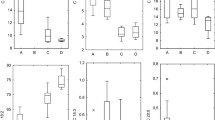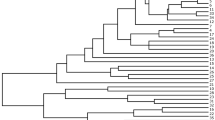Abstract
Pumpkin (Cucurbita pepo L.) seed oil is a common salad oil which is produced in Slovenia, Hungary and the southern parts of Austria. It is dark green and has a high content of free fatty acids. The seed itself can be eaten. Due to its colour and the foam formation, the oil cannot be used for cooking. The content of vitamin E, especiallyγ-tocopherol, is very high. The oil content of the pumpkin seed is about 50%. The variability in the oil content is very high resulting from a broad genetic diversity. Thus a breeding programme for increasing the oil productivity is very promising. The four dominant fatty acids are palmitic, stearic, oleic and linoleic acids. These four fatty acids make up 98±0.13% of the total amount of fatty acids, others being found at levels well below 0.5%.
Similar content being viewed by others
References
Schuster W (1977) Adv Agron Crop Sci 4: 5–52
Murkovic M, Hillebrand A, Winkler J, Pfannhauser W (1996) Int J Food Res Technol 202: 275–278
Nitsch-Fitz R, Egger E, Wutzel H. Maruna H (1979) Acta Med Empirica 12: 1009–1013
Wentzel C (1987) Ernährung/Nutrition 11: 752–755
Schuster W, Zipse W, Marquard R (1983) Fat Sci Technol 85: 56–64
Mancha M, Sarmiento C, Garces R (1995) Acyl turnover in triacyglycerols. Its role in the regulation by temperature of the 18:1/18:2 ratio in sunflower seeds. In: Kader JC, Mazliak P (eds) Plant lipid metabolism. Kluwer Academic Dordrecht, pp 378–380
Mead JF, Alfin-Slater RB, Howton DR (1986) Lipids: chemistry, biochemistry, and nutrition. Plenum Press, New York, pp 133–147
Deutsche Gesellschaft für Fettwissenschaften e.V.M. (1989) Fettsäuremethylester (Bortrifluorid-Methode). Deutsche Einheitsmethoden zur Untersuchung von Fetten, Fettprodukten, Tensiden und verwandten Stoffen, 2nd edn. Wissenschaftliche Verlagsgesellschaft, Stuttgart, pp 1–5
Sachs L (1992) Angewandte Statistik, 7th edn. Springer, Berlin Heidelberg New York, p 497
Marquard R (1990) Fat Sci Technol 11: 452–455
American Heart Association (1988) Circulation 77: 721–724
National Research Council (1989) Diet and health: implication for reducing chronic disease risk. National Academy Press, Washington DC
US Department of Health and Human Nutrition (1990) Nutrition and your health: dietary guidelines for americans 1990-273-930
Health and Welfare Canada (1995) Minister of supply and services. Ottawa, Canada
Thomas LM, Holub BJ (1994) Nutritional aspects of fats and oil. In: Kamel BS, Kakuda Y (eds) Technological advances in improved and alternative sources of lipids. Blackie Academic and Professional, Glasgow, pp 16–49
Author information
Authors and Affiliations
Rights and permissions
About this article
Cite this article
Murkovic, M., Hillebrand, A., Winkler, J. et al. Variability of fatty acid content in pumpkin seeds (Cucurbita pepo L.). Z Lebensm Unters Forch 203, 216–219 (1996). https://doi.org/10.1007/BF01192866
Received:
Revised:
Issue Date:
DOI: https://doi.org/10.1007/BF01192866




